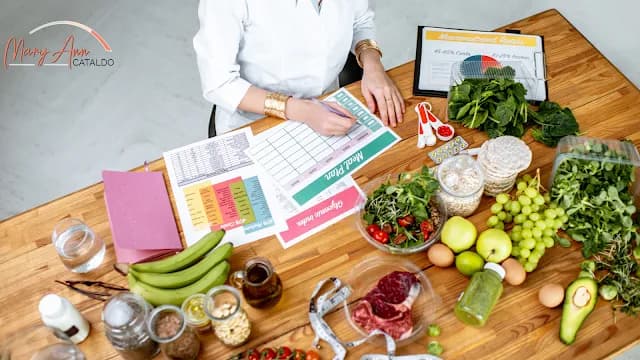Most busy professionals struggle at one time or another to maintain a healthy diet amidst their hectic schedules. With meetings, deadlines, and personal commitments, finding the time and energy to plan nutritious meals can seem overwhelming.
We get stuck wondering things like, “What should I eat to stay energized throughout the day?” or “How can I prepare healthy meals quickly?”.
When you’re unsure what to do, it’s hard to move forward.
The good news is you can easily bring order to the chaos by implementing a well-thought-out meal plan tailored to your busy lifestyle.
In this post, I’ll define what makes a perfect meal plan and provide 3 quick and nutritious recipes to help keep you fueled and focused. I hope that this will give you a roadmap so you can get started with meal planning and achieving your health goals effortlessly.
What is the perfect meal plan for busy professionals?
A perfect meal plan for busy professionals is a well-balanced, easy-to-follow dietary strategy that ensures you get the necessary nutrients without spending hours in the kitchen. This plan prioritizes quick preparation times, simplicity, and variety to keep your meals interesting and healthy.
In other words:
By following this meal plan, you’ll have a clear and efficient guide to preparing nutritious meals that support your busy lifestyle.
The added benefit is that you’ll save time and reduce stress around meal decisions, allowing you to focus more on your work and personal commitments while maintaining your health and energy levels.
Balanced Nutrition – The First Ingredient
Balanced nutrition involves consuming a variety of foods that provide the necessary vitamins, minerals, and other nutrients your body needs to function optimally. This includes a mix of proteins, carbohydrates, healthy fats, and plenty of fruits and vegetables.
This is a crucial component because proper nutrition is vital for maintaining energy levels, supporting brain function, and overall health.
Many people who are new to meal planning start out on the right track but then get stuck because they don’t realize the importance of variety and balance in their diet.
And then they end up giving up because they are bored of eating the same things.
The key to maintaining a balanced diet while having a busy schedule is to plan your meals ahead and ensure each meal contains a good mix of macronutrients.
To get started here, create a simple template for your meals that includes a protein source, a healthy fat, and a portion of vegetables or fruits.
Meal Prep Efficiency – The Second Ingredient
Meal prep efficiency involves organizing your cooking process to maximize your time and effort, ensuring you can quickly prepare meals even on the busiest days. This might include batch cooking, utilizing time-saving kitchen tools, or preparing ingredients in advance.
If you’ve spent hours cooking each day but still feel like you’re constantly pressed for time, this is likely the piece that’s missing.
Without efficient meal prep, you can spend a lot of time in the kitchen and still not have meals ready when you need them.
What can you do?
A useful technique for boosting meal prep efficiency is batch cooking. Spend a couple of hours on the weekend preparing large portions of food that can be divided into individual meals for the week. This not only saves time but also ensures you always have healthy meals available. Invest in good-quality storage containers to keep your meals fresh and easy to access.
Delicious Variety – The Third Ingredient
Delicious variety means incorporating a range of different flavors, cuisines, and ingredients into your meal plan to keep your meals interesting and enjoyable. This encourages you to stick to your healthy eating habits and prevents boredom.
Here’s where you’ll really start to bring it all together. By adding variety, you’ll look forward to your meals, making it easier to stay on track with your nutrition goals.
Of course, this will take some planning and creativity. Consider exploring new recipes, experimenting with different spices, and incorporating seasonal produce.
The approach you can use to incorporate delicious variety is:
1. Plan your meals weekly: Each week, choose one new recipe or ingredient to try.
2. Incorporate different cuisines: Rotate between different types of cuisine to keep things exciting.
3. Use seasonal produce: This not only adds variety but also ensures you’re eating fresh and nutrient-dense foods.
Once you’re done, you’ll be well on your way to maintaining a healthy and enjoyable diet that fits seamlessly into your busy lifestyle.
Putting it All Together for Your Perfect Meal Plan
There you have it! The 3 components of your perfect meal plan.
It may sound like a lot, but like most things practice makes perfect. Just focus on implementing balanced nutrition, enhancing your meal prep efficiency, and adding delicious variety to your meals. This will help you streamline your meal planning process and ensure you’re consistently eating healthy, nutritious meals.
What’s next? Download My Free 3-Day Meal Plan
If you need help getting started, my 3-day meal plan will help you create three days worth of delicious, nutritious meals so you can gain confidence in your meal planning journey.
Click here to download your 3-day Meal Plan now >> sendfox.com/marybos
